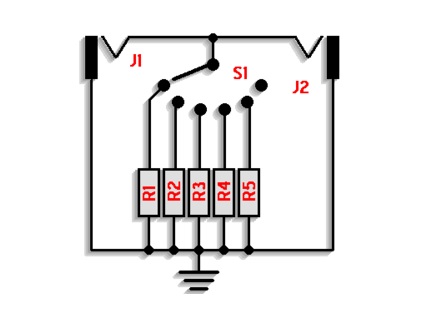Not everybody wants the highest fidelity sound from their guitar
High-impedance guitar and bass inputs were a welcome addition to audio interfaces—you could plug directly into your computer without loading down your guitar’s pickups, which can dull the tone. But what if you want to dull the tone? Some guitarists prefer the loading effects of a low impedance input, because they find a high impedance just too darn crispy. Reduced high frequencies can contribute to a smoother, rounder sound when feeding distortion and overdrive modules in amp sims.
To regain your duller tone, just add a resistor from the hot input to ground. Since you probably don’t want to modify your interface, there are two simple options.
- Wire up a dedicated guitar cord. Solder a resistor with the desired amount of loading (probably 10k or 22k) from either plug’s hot connection to its ground. Identify the cord in some way so you don’t use it by accident.
- Wire up a box using the circuit shown in the image above, with a choice of loading resistors, selected by a rotary switch that has one throw disconnected so you can bypass the resistors. Plug either end into your guitar, and the other end into your interface.
For resistor values, try 4.7k, 10k, 22k, 47k, and 100k. Good luck finding a rotary switch locally…but you can get them from parts-express.com, or if you’re in a nostalgic mood, radioshack.com still exists and has a 2-pole, 6-position switch (part #2750034).
Even if you’re a fan of hi-fi sound, you might be pleasantly surprised at how much a little loading can smooooth out your sound when feeding distortion. Try it sometime – for the cost of butchering a cable and a 10 cent resistor, duller sound can be yours!
